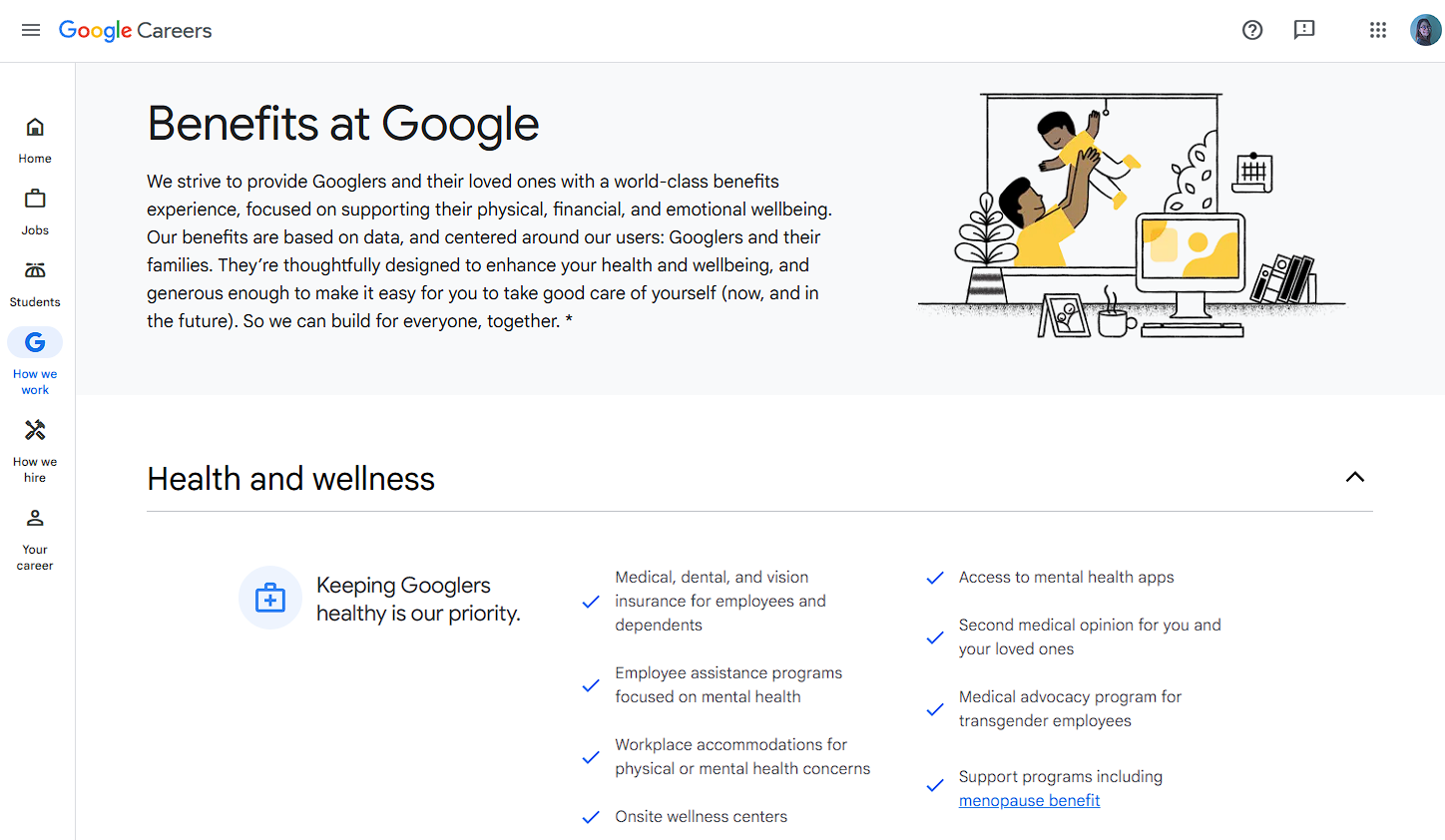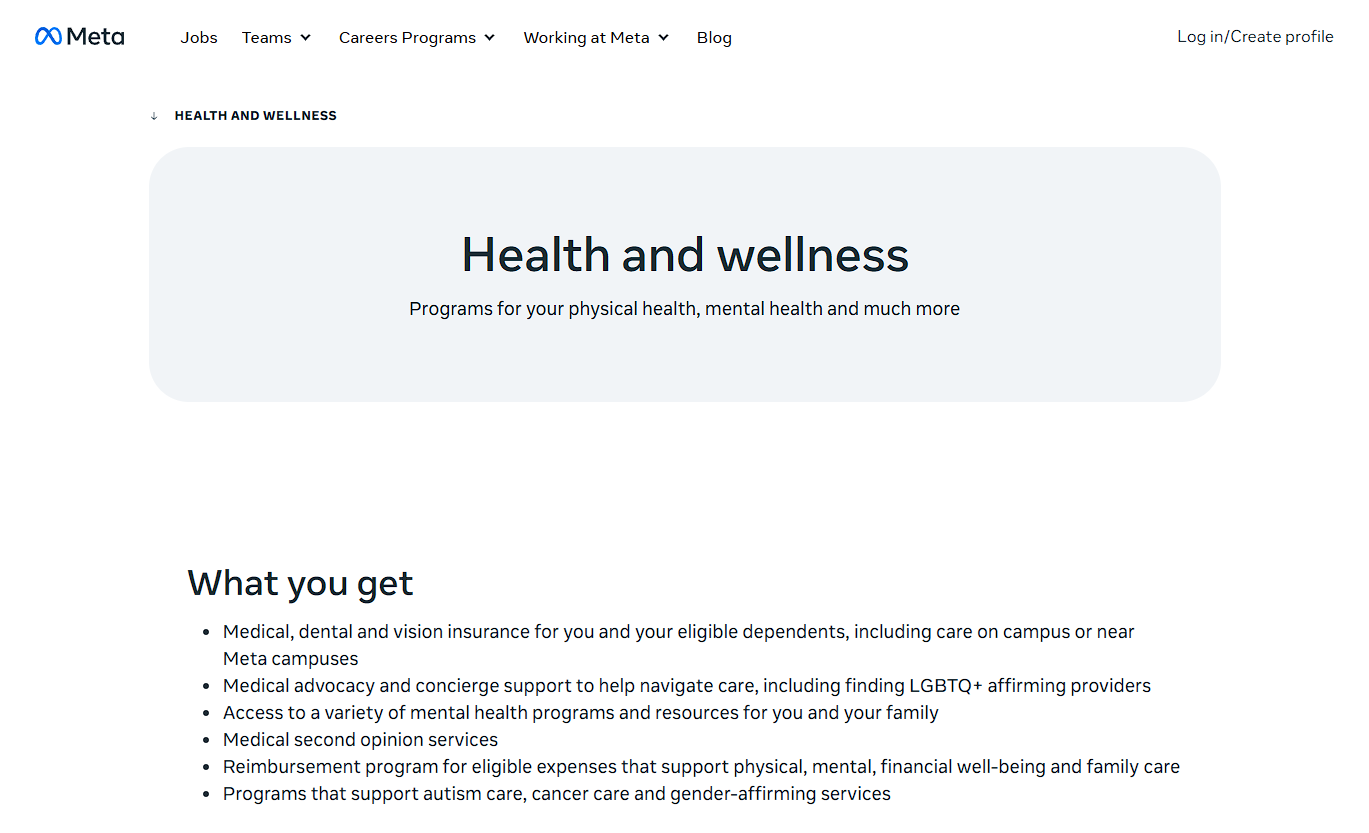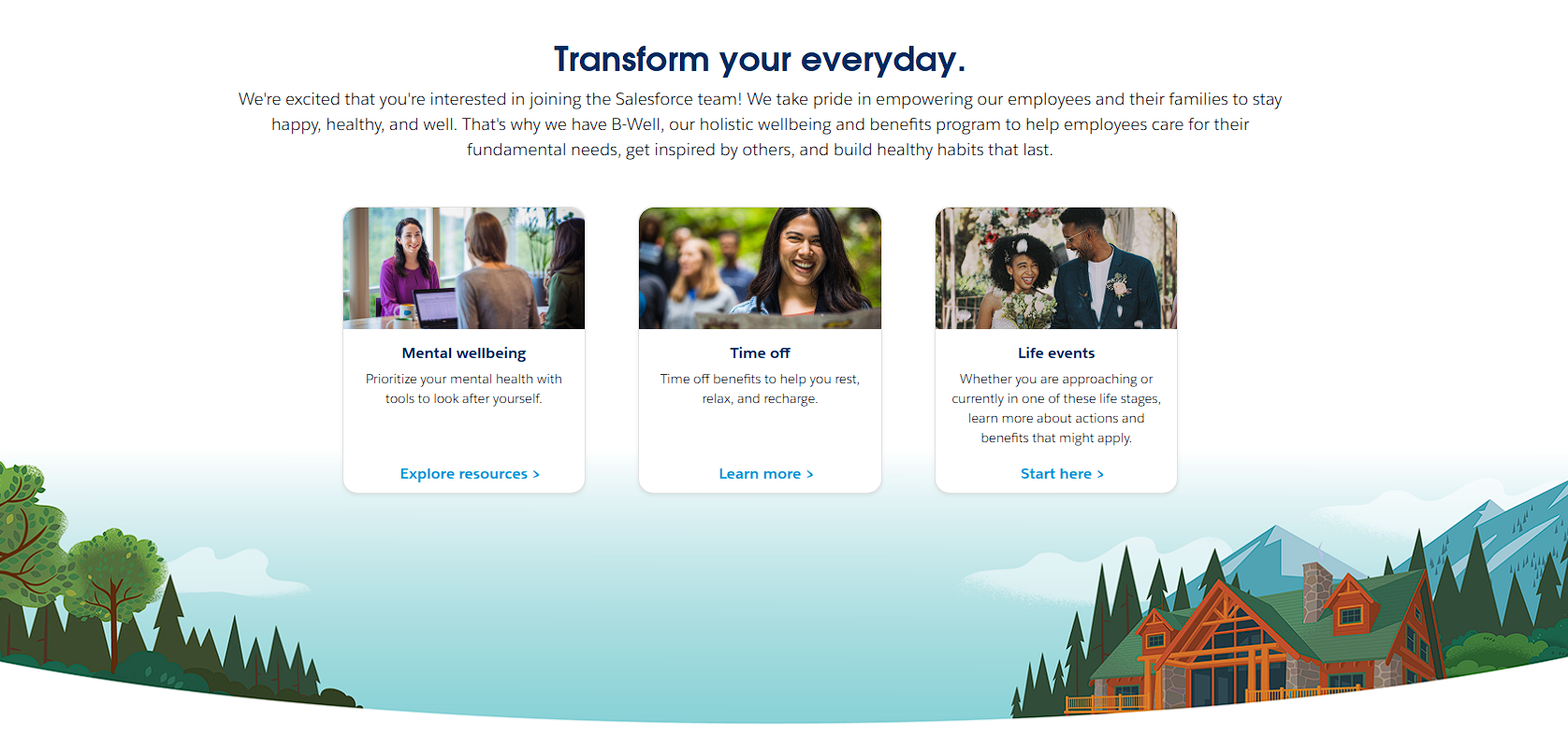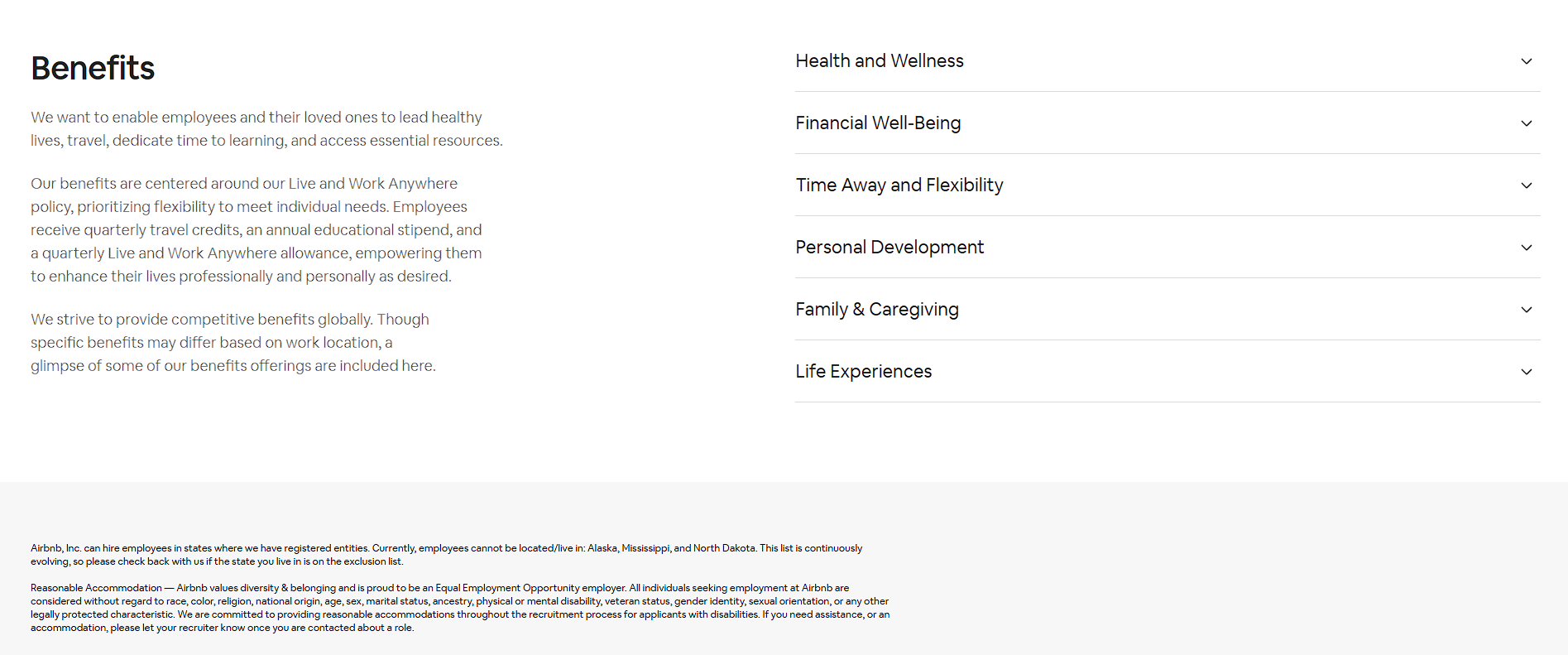In today’s candidate-driven market, employee benefits and perks (often provided via employee assistance programs) can be the difference between securing and retaining talent and losing them to the competition. So you’re probably concerned with whether your company’s offering is attractive enough.
Given that only 40% of employers today offer some form of employee benefits and perks to better support their staff, if you leverage your benefits and perks effectively, you can gain a competitive edge in hiring and keeping the workforce engaged.
This article provides the employee perks and benefits your current and potential employees love.
What Are Employee Benefits?
Employee benefits are indirect forms of compensation that employers must contractually honor in addition to a worker’s annual salary or wages. Employee benefits insurance, like health, dental, and vision insurance, plus retirement and pension plans, are a few popular examples.
Benefits can also be an incentive in making new hires. For example, if you offer more paid time off than the legal minimum, you can call it a benefit.
What Are Employee Perks?
Employee perks (short for ‘perquisites’) are the non-wage offerings that go beyond salary and employee benefits. Gym membership reimbursement, wellness activities, and free food are common examples of employee perks.
A common distinction between benefits and perks is that perks are part of the employee’s remuneration. If an employer fails to honor a benefit, they are in breach of contract. Perks are part of company culture and are given at the company’s discretion.
How Employee Benefits and Perks Help in Attracting and Retaining Employees
The rule is simple: The higher your investment and the better your benefits and perks, the bigger the return on employee retention, productivity, and morale. In fact, compensation and benefits are cited as one of the top three positive influences on retention rates.
Employees need benefits and want perks. But both can be considered investments an employer makes in them. Prospective hires, therefore, use benefits and perks to determine whether an organization will appreciate their efforts in the longer run.
Here are five reasons why offering employee benefits and perks is effective at retaining high-quality employees:
You Get a Higher Quality Candidate Pool and Talent Retention
Offering a benefits package attracts top talent for two reasons:
- It indicates the company has adequate finances to support benefits.
- Employees use it as a deciding factor to choose where to work.
So, if you want to attract and retain top-notch workers, make sure you’re offering top-notch benefits and perks.
Employee Benefits and Perks Ensure a Healthier, Happier Workforce
Your employee benefits package holds a much deeper meaning for employees because it shows them your willingness to support them and their goals.
For example, if you offer paid sick leave, you encourage employees to stay at home when they feel ill. Not only will this give the sick person enough time to recuperate, but it will also prevent them from infecting their co-workers. When they come back, they’ll feel refreshed and ready to go, which is much better than having them struggle at the job and feel resentment towards the management.
By offering health insurance and other wellness benefits, you’ll have a healthier workforce that will lead to a healthy, high-performance business.
As Richard Branson famously said, “Clients do not come first. Employees come first. If you take care of your employees, they will take care of the clients.“
Higher Employee Productivity
So, offering a good employee benefits package can help you land healthy, talented workers who are likely to stay around for the long term. The natural result of this situation? Higher productivity.
Think about it: You’ve successfully hired top-performing employees who know how to get things done. You’ve taken the measures to ensure they're healthy, giving them the physical ability to be present at work each day. You’ve also kept the employees long enough to develop a good workflow and processes.
And that’s just the physical impact — your employees are also doing better mentally. Employees who don’t have to worry about healthcare expenses, save for retirement, or worry about taking care of their children are in a better headspace to focus on their work.
Even studies confirm that happy employees are 13% more productive.
Highly Motivated and Engaged Staff Members
A Harvard Business Review article states that employees only care about three things:
- Career: More specifically their career growth potential.
- Community: Develop a sense of belonging and respect, and
- Cause: The opportunity to work on a mission or cause they're passionate about.
Importantly, mental health has become a top priority. Be sure to provide your workforce with a better work-life balance, flexibility, and mental health assistance. Support your employees' journey towards achieving these three desires by giving them the right benefits and perks.
For instance, offering Toastmasters memberships or holding company-sponsored sports events can make them feel part of a community. Paying for specialized training offers them the opportunity to achieve more in their careers, enabling employees to have a more significant impact on the company’s mission.
Company benefits and perks aren’t the sole influencing factor in your employees’ happiness and engagement. However, these offerings can be a strategic move to fulfill their personal requirements and boost morale.
Strengthened Company Purpose, Values, and Culture
In the past, HR managers chose employee benefits and perks without too much strategic thought. Instead of creating a customized plan according to employee requirements and preferences, they took the “everyone is offering this, so we’ll offer this too“ approach.
Naturally, they didn't get the desired results.
A strategic approach to perks and benefits gives your company a competitive edge. One way to do this is by offering perks that strengthen the company's unique purpose or core values.
When you choose benefits and perks that reinforce company values, such as shared learning or empathy, you reinforce the company’s core values and culture in employees’ everyday lives, resulting in a more pronounced culture.
Airbnb, for example, has an excellent tactic to reinforce its unique culture. It offers employees $2,000 a year for travel allowance — provided they stay with an Airbnb host while traveling. As this puts the employee in an Airbnb customer’s shoes, they develop greater empathy and understanding of the company’s target audience and their needs.
Not a bad tradeoff, right?
20 Employee Perks and Benefits Suggestions
Employee benefits and perks run the gamut from nearly necessary to arguably over-the-top. It’s up to you to decide what will draw in and keep your target talent for the long run.
Fractl conducted a study of 2,000 people, asking participants to weigh in on various benefits when deciding between jobs. While better health, dental, and vision insurance were the top benefits employees desired (88%), other perks like student loan assistance and paid parental leave were also a priority.

Here are some of the best employee benefits and perks to make your employees feel appreciated and motivated:
Healthcare and Wellness Benefits
Not having healthcare in the United States can be a nightmare, considering one has to shell out thousands of dollars just to ride in an ambulance. Employees are likely to choose (and stay with) companies offering solid health and wellness benefits plans to ease the financial burden.
Close to 90% of U.S. employees in large and medium-sized businesses receive healthcare benefits. Here’s how you can support your employee's well-being:
1. Health Insurance
Health insurance is the premium you’ll pay to the insurance provider for your employee’s medical expenses. If you offer a health insurance plan, it will likely cover:
- Doctors visits
- Emergency care
- Prescription drugs
- Specific medical procedures
- Disability insurance
- Vision insurance
- Dental insurance
- Life insurance
Health insurance plans vary from company to company. Some pay the full premium on the employee's behalf; some only contribute to the cost along with a deductible that comes out of the employee's paycheck before taxes.
2. Mental Healthcare and Preventive Care
If you want your employees to feel even more comfortable at work, consider offering them mental healthcare benefits. This can include therapy, mentorship, and coaching.
83% of employers believe their company’s wellness program helped improve staff members’ health. The same study found that 84% of employees saw a positive impact on productivity and performance after implementing mental health clinical services and preventive care programs.
3. Complimentary (Healthy) Lunch
Offering free lunch is a creative employee recognition idea to motivate staff and boost productivity.
As lunchtime approaches, employees start to lose focus, thinking about the logistics of getting lunch. What route should they take to avoid traffic? Will their favorite restaurant have a long line?
Offering them a free, well-balanced meal at the office will take away these worries. Plus, they'll have more energy to continue working efficiently. As a bonus to business, food-centered social gatherings, such as eating lunch together, help foster a sense of camaraderie and encourage collaboration.
4. Wellness Options
Offer daily wellness options to employees to keep them focused and energized throughout the day. This can include offering free snacks, tea, coffee, and water. If you want to get more creative, create a wellness challenge or a nap room and offer ergonomic office furniture that shows employees you care about their health.
5. Free Massages and Yoga Classes
Weekly massages and yoga classes during work hours are great ways to help employees feel comfortable, happy, and creative throughout the workday.
Financial Benefits
According to our employee wellness statistics, financial stress and money worries have had a significant impact on employee mental health (34%), sleep (33%), and physical health (23%). Additionally, financially stressed workers are two times as likely to be on the job hunt. The development of AI and subsequent layoffs and pay cuts have depleted the savings of many workers, creating financial stress and insecurity.
And let’s not forget the mental and potentially physical toll financial stress can have on employees and, by extension, their productivity. Keeping this in mind, here are some employee financial wellness benefits that are highly appealing:
6. Retirement Planning and 401(k)
An SHRM study concluded retirement is the most important financial wellness benefit to employees.
The main reason why employer-sponsored retirement plans work is that it’s easier for employees to save for the future. Not only does it fill financial knowledge gaps, but it also offers employees a means to improve their financial wellness.
If you want to take things a step further and gain a competitive edge, offer retirement plans with contribution matching (401(k)). Employees recognize the value of contribution matching towards the total compensation package and are, therefore, more motivated to stay with the company.
7. Company Equity / Profit Sharing
Consider offering employees a stake in your company or annual profits to attract top-level talent.
Company equity gives employees a sense of ownership. They also have a financial incentive in seeing the business succeed, making them more invested in the company’s growth, development, and profitability.
8. Paid Time Off
Giving your employees their preferred types of paid time off (vacation time, sick leave, personal days, and paid parental leave) helps improve their work-life balance, quality of life, and mental health. You can also give employees a chance to earn more time off based on the number of hours they work or years they’ve been at the company — a great incentive to stay.
9. Access to Emergency Funds
Access to emergency funds is a constant stressor to both employed and unemployed Americans. This makes sense considering that 38% of workers have less than $1,000 in savings to deal with emergencies. Only 44% t of U.S. adults would pay an emergency expense of $1,000 or more from their savings. For 35% of people, the solution would be to borrow the $1,000, either by using their credit card, taking a personal loan, or turning to friends or family.
Traditionally, companies offer short-term loans or payroll advances to workers. But you can also consider giving employees an emergency savings account funded through payroll deductions.
An emergency savings account is just like any other savings account and can be connected to a debit card that is available for the employee to use. Funds are deducted from employees' paychecks, and they can access these funds during emergencies without penalties.
10. Employee Discounts, Rewards, and Bonuses
Discounts and employee rewards programs can help offset living expenses and reward employees for their hard work. They also encourage employees to engage with the company's product or service, increasing their understanding of the customer experience and service level.
Offer your own products and services at a discount, or partner with other businesses for exclusive offers (the best employee recognition software makes this easy to do). You can also give performance bonuses to reward hard-working employees.
Education and Career Planning Benefits
Both the employee and employer have a vested interest in seeing talented workers advance up the career ladder.
From an employer's perspective, employees with procedure experience, specialized knowledge, and newly developed skills are ideally equipped to contribute to the company's success. For employees, working for an employer who is ready to invest in their professional development ensures career growth.
To enjoy this win-win situation, offer the following to support your employees’ future career growth and education:
11. Employee Growth Plan
It makes sense for employees to be with a company where they can grow. If they don’t see a bright future at your company, they‘ll leave as soon as a better opportunity comes knocking at their door.
Sit down with employees and create their future growth plans to engage and motivate them. This will give them hope for a solid future career at your company.
12. Tuition Reimbursement
Offering tuition reimbursement is a valuable benefit to entice top-quality candidates — and for good reason. The average federal student loan debt is $36,510 per borrower, while private student debt averages $54,921 per borrower.
Now, that’s some serious money!
Offering some form of tuition assistance can help offset employees‘ education expenses, along with giving them the chance to acquire more skills and tools to become better at their jobs.
Alternatively, you can set up a student loan repayment option to support your employees‘ financial wellness and mental health. For instance, you can help them figure out monthly loan payments based on family size and income, which will help them pay off their debts while considering other financial responsibilities and needs.
13. Financial Coaching
Many employees lack financial literacy—not because they don’t want it, but because they don’t have the education necessary to understand how much income they’ll need for the future and plan accordingly.
Set up employee financial wellness programs and partner with financial consultants to educate your staff members on budgeting, saving, investing, and paying off or managing debt. Plus, if you plan on providing the financial benefits we discussed, educating employees about the benefits of those programs makes sense.
14. Career Development Training
Offering skills training initiatives like coding or MS Excel during work hours can enable employees to learn valuable new skills without giving up on their personal time.
15. Personal Development Training
Personal development can help your employees reach their full potential, resulting in a productive and motivated workforce. Not only will this type of training make them more self-aware, but it’ll also promote resilience to work-related stress because of their improved cognitive appraisal.
Again, try to provide personal development training during work hours to encourage participation.
Employee Recognition and Engagement Benefits
Meaningful and timely recognition and engagement promote employee morale at work, build positive relationships, and boost productivity. According to a 2018 Society for Human Resource Management (SHRM) employee recognition study, it positively affects the overall employee experience (89%), employee relationships (87%), and employee engagement within the workplace (84%).
From sharing a few appreciative words with employees to giving employees award titles, small gestures can make a lot of difference. If you want to go further with acknowledging their efforts, offer them the following benefits and perks:
16. Employee Recognition Programs
Recognize your employees’ hard work by developing and implementing employee recognition program ideas.
Most common employee recognition programs include free health checks, work anniversary celebrations, and free employee recognition ideas like simple thank-you awards or shoutouts. But you can customize rewards depending on your and your employees’ unique needs.
17. Plenty of Time Off
If your employees work hard, let them also play hard. In addition to offering the mandatory vacation time (at least three weeks), let your staff members enjoy paid time off on their birthday and a bonus vacation week.
Reward employees for long tenure. Offer the fourth week of vacation every year for those who have completed four years, or make employees eligible for Friday vacation days during summers after they reach five years of employment.
18. Flexible Scheduling and Remote Working
Working in an office environment works great for bringing employees together and cultivating a sense of belonging. But many employees prefer flexible scheduling or work-from-home opportunities.
Case in point, over 54% of employees want to continue working from home post-pandemic, according to the Pew Research Center.
Offer perks that make working from home easier, like a home office budget or food delivery service. Recently, many companies have started switching to a 4-day workweek, which is again something you should consider to attract talent.
Now, you don't have to go remote overnight—this is something you can ease into.
Let employees work from home a few times a week, and do away with the traditional 9-to-5, Monday to Friday work schedule. Talk to your employees to create a flexible schedule, outlining which days and times they will work to avoid confusion.
If you don’t want to give employees control over their work hours, consider other options like giving them an extra day off every month, leaving work early every other Friday, or alternating between working mornings, afternoons, or evenings.
19. Team Parties During Work Hours
Host company parties celebrating big and small wins during work hours. If your team is remote, have a virtual happy hour or team lunch over Zoom or Skype.
20. Team Building Activities
Remote working unquestionably has many advantages, but it can also lead to a disconnect between team members. Luckily, team-building activities can help co-workers bond and create a relaxing, fun atmosphere that also lets them form deeper connections.
Make sure everyone gets a say during a team-building event. Use an employee engagement platform to hold discussions and surveys, and encourage everyone to share their opinions.
Dos and Don’ts of Employee Perks and Benefits
From Deloitte’s family-focused benefits to Ben & Jerry’s daily pints of ice cream for employees, the modern employee is definitely living in an amazing era.
But simply offering employee benefits and perks isn’t enough — you also have to do it right. Below are the dos and don’ts of effective employee benefits and perks plans:
Do:
- Make your employee benefits plan transparent, so everyone is clear on what it entails.
- Customize benefits and perks according to your employees’ unique interests and aspirations.
- Encourage employees to take advantage of benefits and perks.
- Update your benefits plan with changing times.
- Make benefits accessible to everyone, regardless of tenure, position, gender, or sexual orientation.
- Schedule activities and training during work hours.
- Host inclusive activities that everyone can take part in and contribute to.
Don’t:
- Offer irrelevant or stale benefits that are of no use to your employees.
- Skip the basics like health insurance, paid maternity leave, and retirement support.
- Let a perk vendor promote their name and brand instead of your company. When an employee takes advantage of a corporate perk, they should be thankful to you, not the perk vendor.
- Offer perks that don’t work for the modern employee.
- Forget about remote employees.
- Force employees to attend training or programs in their personal time.
Companies with great benefits Packages
Many companies have made notable efforts toward establishing an effective employee benefits program that resonates with their employees and increases overall employee satisfaction and motivation.
Here are five companies we believe offer remarkable employee benefits and office perks.
Google’s excellent benefits package is one of the main reasons why it’s many people’s dream employer.

Besides the basics (health insurance, 401(k), paid time off), the company offers its employees free legal advice, travel insurance, and on-site medical care. And that’s not it — an Insider article reported that Google employees get free meals at work, free workout classes, and free massages.
New mothers get extra cash and vacation time, while other staff members can request help from an emergency travel assistance service. Employees who love sports can enjoy volleyball courts and heated swimming pools. Additionally, Google not only matches employees' charitable contributions, but for every five hours of volunteer time, the company donates $50 to that nonprofit.
Meta
A multi-billion-dollar company Meta offers employees benefits that cover free housing and healthcare coverage, wellness allowances, and several other items in addition to a substantial salary. For context, entry-level interns take home over $7,000 a month.

The company also has some of the most unique and beautiful offices in the world, with tons of fun amenities. An on-site barbershop ensures employees always look polished, while an arcade full of video games makes for fun team bonding sessions.
A parent himself, founder Mark Zuckerberg is passionate about offering parents and expecting parents additional assistance. Meta offers four months of paid parental leave, plus a $4,000 bonus to employees who have just had a newborn.
Starbucks
Starbucks has a mix of serious benefits and perks for its employees.

The company offers a family expansion reimbursement program (assisting eligible partners with specific costs of growing their families), tuition reimbursement, and excellent healthcare and well-being programs, as well as free dry cleaning, Spotify subscriptions, and weekly coffee and tea supplies.
What's more, eligible employees can earn a bachelor’s degree with 100% tuition coverage, coaching, counseling, and advising. Starbucks also takes care of its employees’ work-related commuter expenses.
Salesforce
Salesforce employees enjoy a lot of flexibility when it comes to employee benefits.

The company allows them to set aside a maximum of $510 in tax-free income to cover parking and commuting costs. Plus, they can use special wellness perks or sign up for travel and education programs.
Salesforce also pays university tuition for workers wanting to upskill and gain more expertise in their field and reimburses them for buying textbooks. While the company limits qualified donations to $5,000 a year, it encourages employees to give back to the community by matching their charitable contributions.
Employees can also enjoy $100 worth of massage therapy or yoga classes, along with discounts on cleaning services, concert tickets, and several other purchases.
Airbnb
Airbnb is well known for their employee benefits package, so you know they’re doing something right.

The company offers excellent healthcare options, including medical, dental, vision, life insurance, and disability—all covered 100% for the employee and up to 70% for dependents. It also matches 3% on employees’ 401(k) contributions and allows employees to use ESPP (the option to buy company stock at a 15% discount).
Generous paid time off options and a comprehensive leave policy ensure Airbnb employees are well-rested and enjoy a healthy work-life balance. Office perks include innovative office spaces, local and worldwide travel benefits, and an in-house chef.
Our Last Words on Employee Benefits and Perks
The employee benefits and perks you choose to offer your workforce matter. Be strategic in what culture committee ideas you develop to cultivate a productive, inclusive culture that supports employee requirements and aligns with your company values and mission.
By ensuring your company offers desirable benefits and perks, you also let your employees feel valued, making them more likely to stick around.



























